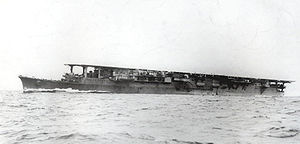Japanese aircraft carrier Ryūhō

Ryūhō in 1942
|
|
| History | |
|---|---|
|
|
|
| Name: | Taigei |
| Operator: | Imperial Japanese Navy |
| Builder: | Yokosuka Naval Arsenal |
| Laid down: | 12 April 1933 |
| Launched: | 16 November 1933 |
| Completed: | 31 March 1934 |
| Out of service: | 12 December 1941 |
| Renamed: | 30 November 1942 |
| Fate: | converted to light aircraft carrier |
| Name: | Ryūhō |
| Namesake: | Japanese for Dragon Phoenix |
| Recommissioned: | 30 November 1942 |
| Struck: | 30 November 1945 |
| Fate: | Scrapped in 1946 |
| General characteristics | |
| Class and type: | Ryūhō-class aircraft carrier |
| Displacement: | 16,700 tonnes (16,400 long tons) (full load displacement) |
| Length: | 215.65 m (707 ft 6 in) (o/a) |
| Beam: | 19.58 m (64 ft 3 in) |
| Draft: | 6.67 m (21 ft 11 in) |
| Installed power: | 52,000 shp (39,000 kW) |
| Propulsion: |
|
| Speed: | 26.5 knots (49.1 km/h; 30.5 mph) (design) |
| Range: | 8,000 nmi (15,000 km; 9,200 mi) at 18 knots (33 km/h; 21 mph) |
| Complement: | 989 |
| Sensors and processing systems: |
1 × Type 2, Mark 2, Model 1 air search radar |
| Armament: |
|
| Aircraft carried: | 31–36 |
Ryūhō (龍鳳?, "Dragon phoenix") was a light aircraft carrier of the Imperial Japanese Navy. She was converted from the submarine tender Taigei (大鯨, "Great Whale"?), which had been used in the Second Sino-Japanese War . One of the least successful of the light aircraft carrier conversions due to its small size, slow speed and weak construction, during World War II, Ryūhō was used primarily as an aircraft transport and for training purposes, although she was also involved in a number of combat missions, including the First Battle of the Philippine Sea.
The London Naval Treaty imposed limitations on new construction of major capital warships for the major world powers. The Imperial Japanese Navy responded in part by the construction of auxiliary vessels, such as fleet oilers and submarine tenders, designed so that they could be converted quickly into aircraft carriers in time of conflict. Taigei was ordered as part of the 1st Naval Armaments Supplement Programme of 1932.
Although Taigei was designed from the onset for possible later conversion to an aircraft carrier, the design proved to have many shortcomings. The basic design of the hull suffered from a high freeboard with a shallow draught, which resulted in poor stability. Although extensive use of electric arc welding on the hull speeded construction time and was considered highly innovative for the time, lack of experience with this technique led to many weak welds, and the ship suffered from frequent cracks. Inadequate sectioning into waterproof compartments below her waterline, combined with the weak construction of her hull, also made the ship vulnerable in combat situations. The new vessel was also plagued by the poor performance of its diesel engines, which gave only half the output expected.
...
Wikipedia
